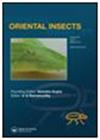Seasonal population dynamics of the common chewing lice Columbicola columbae infesting the domestic pigeon Columba livia
IF 0.6
4区 农林科学
Q4 ENTOMOLOGY
引用次数: 1
Abstract
ABSTRACT The biological and ecological factors experienced across the lifespan by the bird hosts affect the seasonal dynamics of their ectoparasites. The seasonal population of Columbicola columbae which infests the domestic pigeon Columba livia domestica, in Egypt was studied across four seasons in Cairo, Egypt. 25 pairs (25 ♀ and 25 ♂) of Columba livia domestica were visually assessed for chewing lice infestation, twice a month for one year from March 1st 2019 to February 28th, 2020. Life stages (nymphs and adults) of C. columbae were represented across the four seasons. Environmental conditions such as temperature and humidity play a significant role in shaping the population dynamic of this ectoparasite. The intensity rate of C. columbae displayed the highest peak of 78.65 ± 15.28 in autumn, followed by 59.67 ± 20.58 in summer, 26.65 ± 16.66 in winter, and finally 18.65 ± 7.41 in spring. The infestation level of lice was much higher on females (93.64 ± 7.53) than males (81.40 ± 8.70) pigeons. The fluctuations in C. columbae population intensity on pigeons could be related to external environmental factors and host-related factors, which are affected by the season.家鸽常见食虱危害的季节种群动态
鸟类寄主一生中所经历的生物和生态因素影响其体外寄生虫的季节性动态。2019年3月1日至2020年2月28日,在埃及开罗对埃及家鸽(Columba livia domestica)的食虱种群进行了四季调查,对25对家鸽(25♀和25♂)进行了食虱侵染目测,每月2次,为期1年。柱孢虫的生命阶段(若虫和成虫)跨越四季。环境条件,如温度和湿度在塑造这种体外寄生虫的种群动态中起着重要作用。秋柱孢的强度率最高,为78.65±15.28,夏季为59.67±20.58,冬季为26.65±16.66,春季为18.65±7.41。雌鸽(93.64±7.53)只明显高于雄鸽(81.40±8.70)只。鸽子上柱状假体种群强度的波动可能与外部环境因素和宿主相关因素有关,并受季节的影响。
本文章由计算机程序翻译,如有差异,请以英文原文为准。
求助全文
约1分钟内获得全文
求助全文
来源期刊

Oriental Insects
生物-昆虫学
CiteScore
1.60
自引率
0.00%
发文量
34
审稿时长
>12 weeks
期刊介绍:
Oriental Insects is an international, peer-reviewed journal devoted to the publication of original research articles and reviews on the taxonomy, ecology, biodiversity and evolution of insects and other land arthropods of the Old World and Australia. Manuscripts referring to Africa, Australia and Oceania are highly welcomed. Research papers covering the study of behaviour, conservation, forensic and medical entomology, urban entomology and pest control are encouraged, provided that the research has relevance to Old World or Australian entomofauna. Precedence will be given to more general manuscripts (e.g. revisions of higher taxa, papers with combined methodologies or referring to larger geographic units). Descriptive manuscripts should refer to more than a single species and contain more general results or discussion (e.g. determination keys, biological or ecological data etc.). Laboratory works without zoogeographic or taxonomic reference to the scope of the journal will not be accepted.
 求助内容:
求助内容: 应助结果提醒方式:
应助结果提醒方式:


